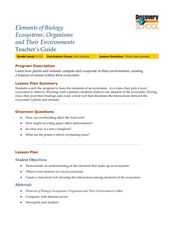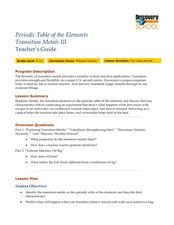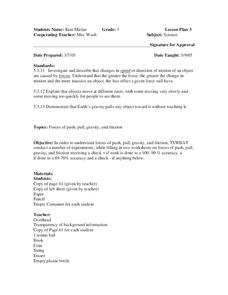Curated OER
Message in the Bottles
Students identify the three realms of the Arctic Ocean, and describe the relationships among these realms. They explain the relationships between gross primary productivity, net primary productivity, and respiration.
Curated OER
Pets: Oh Behave
Students develop an understanding of how innate and learned behaviors and the environment determine behavior. They see how a variety of factors affects our pet's behavior-including species-specific traits, the environment, training, and...
Curated OER
Oil Spill!
Young scholars examine how oil spills are cleaned through an interactive program. They review the facts of oil spills and how the oil spreads. They discuss the short and long term effects of a spill and how they can be avoided.
Curated OER
Have a Heart!
Students assume the role of a doctor, detective, and decision maker. They research the function of the heart, the diseases associated with the heart, and lifestyle choices that are heart healthy. Information gathered will be placed in a ...
Curated OER
A House for Me- Ocean Environments
Learners explore ocean environments. For this ocean environment lesson, students identify the things ocean animals need for survival. Learners use KWL charts and search the Internet collecting information about ocean habitats. Students...
Curated OER
We Are Lunar tics!
Second graders, working in cooperative groups, will create a multimedia presentation about the Earth's moon. Their research must be presented through three or more methods. (i.e. charts; graphs; oral reports; multi-media; dramatic role...
Curated OER
WaterWeb
In this water worksheet, students answer 10 multiple-choice questions about the water cycle. Students also describe how they think their community is involved in sustaining water resources and write a pretend radio announcement about...
Curated OER
Organisms and Their Environments
Students study a local ecosystem and research the organisms to create a food web. In this ecosystem lesson, students view a video and answer questions. They visit a local ecosystem and make a list of organisms to research. Students...
Curated OER
Periodic Table of the Elements: Noble Gases
Students research how neon signs are made and design their own. In this periodic table lesson, students familiarize themselves with the noble gases on the periodic table. They watch a video, research how neon signs are made, and design...
Curated OER
Periodic Table of the Elements: Transition Metals
Students conduct an exothermic reaction to investigate the properties of a transition metal. In this periodic table lesson, students identify the transition elements and discuss their properties after watching a video. They conduct an...
Curated OER
Summer Camp 2050
Students create a camp for the future. In this simulation activity, students will research various energy sources, and create a proposal for the "city council" to recommend what energy sources should be used for a summer camp in the year...
Curated OER
What is it...A Frog or a Toad?
Students write a story. In this frogs and toads comparison lesson, students read facts comparing frogs and toads, use a t-chart to record factual information and complete a Venn Diagram. Students complete a four square writing template...
Curated OER
Guetemala's Changing Forest
Eighth graders compare their local ecological zone to the tropical rainforest. In this natural ecology lesson, 8th graders complete an activity about the differences in ecological zones. They compare their biome to the Guatemalan...
Curated OER
Bermuda: Search for Deep Water Caves: Living Fossils
Students explore relict species. In this anchialine cave activity, students identify relict species associated with anchialine caves, and explain the importance of preserving anchialine caves and species.
Curated OER
Osmosis and Diffusion: Egg Lab
Students examine why diffusion and osmosis happen in an egg cell. In this diffusion lesson students demonstrate a semi permeable membrane.
Curated OER
Force
Fifth graders move a variety of objects in different ways to observe the different forces. In this physics lesson, 5th graders observe pushing, pulling, gravity, and friction. The hands-on component, and teamwork involved, should make...
Curated OER
Surveying and Assessing the Environmental Compatibility of a Building Construction Site
Students examine an area of land and assess its suitability for construction purposes. This project requires a vast amount of hands-on experimentation, data analysis, community involvement, and job shadowing/career awareness.
Curated OER
Being Productive in the Arctic Ocean
Students identify the three realms of the Arctic Ocean, and describe the relationships between these realms. They identify major factors that limit primary productivity in the Arctic Ocean.
Curated OER
Progression's Price
Students reflect upon their regional and national environments, analyze causes of environmental problems as well as their implications, and examine effects of population growth as they participate in "The Popcorn Game."
Curated OER
Gray Whales
Explore the majestic grey whale while deepening your understanding of animal adaptations. Grey whales from head to toe are specifically designed to fit their environment. Learners will examine the ways in which the flippers, head, body,...
Curated OER
It's Alive! Or is it...?
Students apply their knowledge of the characteristics of living things to unknown creatures to determine whether they can be considered "alive." They watch a Star Trek episode, then describe the characteristics of life.
Curated OER
Hot Food
Learners compare and contrast photosynthesis and chemosynthesis as processes that provide energy to biological communities. They investigate the energy content of hydrocarbons used in coral communities.
Curated OER
Kids and Chemicals - Facts and Laws
Students examine the impact of everyday toxins on the health of people. They conduct a cost-benefit analysis, watch a video, conduct Internet research, complete a Synthetic Chemical Exposure Chart, and write a one-page summary.
Curated OER
Economy of Ecology
Students work in groups to decide which statement best fits with each type of sustainable development from a handout about specific strategies countries are utilizing to promote sustainable development.

























